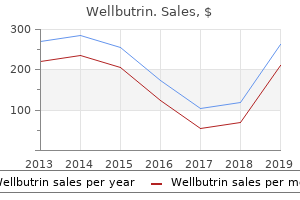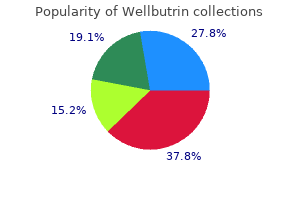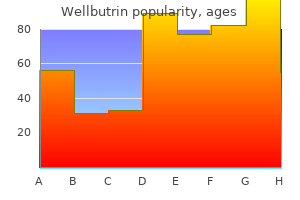Wellbutrin
"Buy wellbutrin without prescription, great depression definition apush".
By: I. Hassan, M.B. B.CH., M.B.B.Ch., Ph.D.
Medical Instructor, State University of New York Downstate Medical Center College of Medicine
Page 91 of 260 Sudden dying occurs when a person goes from a traditional state of health to dying inside 1 hour depression facts wellbutrin 300mg without prescription. The incidence of crashes attributable to sudden dying is relatively low anxiety 30000 diagnosis order 300mg wellbutrin free shipping, primarily because of the length of time between the onset of the cardiovascular event and the incapacitation of the motive force depression symptoms after death of loved one buy wellbutrin 300mg on-line. Emphasize that the motive force could have only a short while following the onset of symptoms to safely stop the automobile and call for medical help depression test elderly order wellbutrin overnight delivery. Tolerate cardiovascular medication and be: o Knowledgeable about medicines used whereas driving. Decision Maximum certification interval - 1 12 months Recommend to certify if: the motive force: Page ninety two of 260 � � � � � Is asymptomatic. Recommend to not certify if: the motive force has: � � � Rest angina or change in angina sample inside three months of examination. Monitoring/Testing the motive force should obtain: � � Clearance from a cardiovascular specialist who understands the capabilities and calls for of economic driving. The presence of this condition normally implies that at least one coronary artery has hemodynamically vital narrowing. When evaluating the motive force with angina, you should distinguish between secure and unstable angina. The presence of unstable angina may be a precursor to a cardiovascular episode recognized to be accompanied by syncope, dyspnea, collapse, or congestive cardiac failure. Stable angina May be precipitated by a predictable sample, including: � � Exertion. Unstable angina Has an unpredictable course characterised by: � � � Pain occurring at relaxation. Decision Maximum certification interval - 1 12 months Recommend to certify if: the motive force: � � � � Has secure angina. Recommend to not certify if: the motive force has had unstable angina inside three months of examination. Monitoring/Testing the motive force should obtain: � � Evaluation from a cardiovascular specialist who understands the capabilities and calls for of economic driving. Monitoring/Testing the motive force should obtain: � � Ongoing treating provider follow-up. Decision Maximum certification interval - 1 12 months Recommend to certify if: the motive force: � � � � � Is asymptomatic. In the setting of an uncomplicated, elective procedure to treat secure angina, the post-procedure waiting interval is 1 week. The waiting interval allows for a small menace attributable to acute complications on the vascular entry website. Decision Maximum certification interval - 1 12 months Recommend to certify if: the motive force: � � � Is asymptomatic at examination. Page ninety eight of 260 Recommend to not certify if: the motive force has: � � � Incomplete healing or complication at vascular entry website. The driver should obtain: � � Clearance from a cardiovascular specialist who understands the capabilities and calls for of economic driving. Typical angina symptoms should prompt analysis with a stress imaging examine or repeat angiography. Congenital Heart Disease Heart failure and sudden dying are the main causes of dying amongst people with congenital coronary heart illness. Due to the complexity of these issues, the Cardiovascular Advisory Panel Guidelines for the Medical Examination of Commercial Motor Drivers advocate that the motive force has regular, ongoing followup by a cardiologist knowledgeable in adult congenital coronary heart illness. As a medical examiner, your determination to certify must be primarily based on: � � � � � Anatomic diagnosis. Advances in surgical and medical administration are anticipated to end in an elevated number of people with congenital coronary heart illness seeking driver certification. Ebstein Anomaly Ebstein anomaly is a congenital downward displacement of the tricuspid valve. Adults with a mild type of Ebstein anomaly can remain asymptomatic throughout their lives. Decision Maximum certification - 1 12 months Recommend to certify if: the motive force: � � � � Is asymptomatic.

The danger of opposed outcomes in continual kidney illness can be additional stratified by the severity of illness and price of progression depression or anxiety quiz discount wellbutrin generic. Therefore depression diagnosis definition order 300 mg wellbutrin overnight delivery, for most patients emotional depression definition purchase wellbutrin overnight, the chance of opposed outcomes tends to increase over time depression symptoms self loathing purchase wellbutrin us. The major task of the Work Group was to develop ``A Clinical Action Plan'-an strategy to continual kidney illness that relates phases of severity of continual kidney illness to methods for prevention and remedy of opposed outcomes. To accomplish this task it was first necessary to outline the conceptual strategy, together with operational definitions of continual kidney illness and the phases of severity of continual kidney illness; determination of the prevalence of continual kidney illness; issues in the analysis and management of various kinds of continual kidney illness; definition of people at increased danger of continual kidney illness; definition of outcomes of continual kidney illness; association of complications of continual kidney illness with decreased kidney operate; modalities of kidney replacement therapy; and an strategy to continual kidney illness utilizing the guidelines. Public Health Problem 29 illness, neither is there dependable info on the prevalence, remedy patterns, outcomes, and value of those earlier phases, nor info on how many individuals choose to forego dialysis and transplantation regardless of kidney failure. This section introduces the rationale for growing a definition of continual kidney illness and classification of phases of severity; danger components for opposed outcomes of continual kidney illness; the relationship between illness severity and price of progression as risks for opposed outcomes; the definitions and phases defined by the Work Group; and laboratory checks for the detection of each stage. More dependable estimates of the prevalence of earlier phases of illness and of the inhabitants at increased danger for development of continual kidney illness; 2. Recommendations for laboratory testing to detect earlier phases and progression to later phases; 3. Evaluation of factors associated with a excessive danger of progression from one stage to the next or of development of other opposed outcomes; 5. Defining continual kidney illness and phases of severity requires ``categorization' of continuous measures of markers of kidney harm and level of kidney operate. However, recognition of the stage of continual kidney illness would facilitate software of pointers, efficiency measures, and high quality enchancment efforts. In other fields of medication, classifications of phases of severity of sickness have been adopted with apparent success, such as the New York Heart Association classification of coronary heart illness. Within nephrology and associated disciplines, classifications of illness severity have been developed that are based mostly on ``categorization' of continuous measures of illness severity. For instance, the Joint National Committee for the Prevention, Detection, Evaluation and Treatment of High Blood Pressure has defined phases of hypertension based mostly on blood stress level. The National Cholesterol Education Program has defined phases of hypercholesterolemia based mostly on serum ldl cholesterol level. These classifications have facilitated epidemiological studies, scientific trials, and software of scientific practice pointers. This guideline concerns itself primarily with identifying susceptibility and initiation components to outline individuals at excessive danger of growing continual kidney illness, and with progression components, to outline individuals at excessive danger of worsening kidney harm and subsequent loss of kidney operate. Relationship Between Disease Severity and Rate of Progression as Risks for Adverse Outcomes In precept, one could distinguish between the severity of illness and the chance for opposed outcomes of illness. The severity of illness can be determined from measurements of level of organ operate, complications in other organ methods, morbidity (signs and scientific findings), and impairment in total operate and nicely-being. In addition, the chance for opposed outcomes can also be depending on the speed of progression to a more severe stage or the speed of regression to a less severe stage. For the case of continual kidney illness, these ideas can be illustrated by Fig 4. The horizontal dotted line corresponds to the level of kidney operate on the onset of kidney failure. The declines in kidney operate in 4 individual patients (A via D) are illustrated as diagonal traces. At the invention of continual kidney illness (t0), patients A and B share equivalent levels of kidney operate, as do patients C and D, but the level of operate is decrease in patients C and D than for patients A and B. Patients A and C have equivalent rates of decline in kidney operate, as do patients B and D, but the price of decline is faster in patients B and D than in patients A and C. Patient D, with the decrease initial level of kidney operate and the quicker price of decline in kidney operate, reaches kidney failure first (t1). Patient B, with the higher initial level of kidney operate but quicker price of decline, and affected person C, with the decrease initial level of kidney operate and slower price of decline, reach kidney failure on the same time (t2). Patient A, with the higher initial level of kidney operate and the slower price of decline in kidney operate, has not reached kidney failure by the top of followup (t2). Figure 4 illustrates that the chance of growing kidney failure relies upon both on the level of kidney operate on the discovery of continual kidney illness and the speed of decline in kidney operate. The object of therapy for continual kidney illness would be to detect kidney illness at a better level of kidney operate (open arrow) and to reduce the speed of decline in kidney operate thereafter (stuffed arrows), thereby decreasing opposed outcomes of continual kidney illness. Operational Definition of Chronic Kidney Disease and Stages One of the primary tasks of the Work Group was to outline continual kidney illness, no matter the specific pathological features of the illness.

It is therefore really helpful that these pointers be adopted by all nuclear medication practices mood disorder nos 2969 quality 300mg wellbutrin. The minimum quality management checks are intended to detect problems before they have an effect on scientific affected person research depression hair loss purchase discount wellbutrin. Further checks may be required to hint the reason for a problem and to ensure that the equipment is performing properly after service or adjustment anxiety young adults buy wellbutrin 300 mg on line. Exact quality management procedures vary between manufacturers and fashions depression symptoms wanting to be alone purchase generic wellbutrin line, making it impractical to present detailed quality management procedures covering all equipment. In order to make quality management procedures so simple as possible, the next is a suggested record of the minimum test equipment required: (a) Cobalt-fifty seven sheet supply this supply is really helpful for high rely extrinsic uniformity checks and the gathering of uniformity correction floods. It is preferable to water stuffed flood tanks, which can introduce non-uniformities due to poor mixing, bulging 118 four. On some methods, a water stuffed flood tank can also be required to calibrate the system for non-99mTc radionuclides similar to 67Ga. The finest bars should be small enough to test the intrinsic resolution of the system (i. It is crucial that quality management procedures be carried out in a consistent method (i. Proper record maintaining significantly facilitates detection of gradual deterioration of performance over an prolonged time frame. A baseline set of quality outcomes should be recorded after set up and acceptance testing to serve as a reference. For each quality management test listed under, the goals and rationale are described first, followed by a basic procedure for performing the test. Although suggestions are made on the frequency of the standard management checks, it must be identified that in some checks this is determined by the equipment. It is really helpful that, on the basis of these pointers, an skilled nuclear medication physicist draw up detailed quality management protocols to be used with particular equipment. In follow, the routine quality management checks should give knowledge that allow the physician to decide whether: - To image patients normally; - To image patients but request that the equipment be serviced; - To stop affected person research till the system is repaired. Rationale and outline of quality management checks: planar (a) Visual inspection A visual inspection of the collimators should be carried out daily and whenever collimators are modified. Signs of latest dents, scratches or stains should be followed up with a background and/or contamination examine and an extrinsic uniformity examine before a suspect collimator is used for affected person imaging. It should be borne in mind, however, that not all collimator injury may be externally visible. A basic visual inspection for another defects that will compromise affected person or employees security (e. The complete variety of counts acquired in a set time period and inspection of the energy spectrum will indicate the presence of any unusually excessive ranges of background radiation. A excessive studying in any explicit path could indicate background radiation from contamination (e. A excessive studying that persists irrespective of the camera head orientation is indicative of contamination on the crystal face or the gamma camera head itself. The above background radiation checks should be repeated with the collimator switched on. If such contamination is indicated, an extrinsic uniformity examine should be carried out to assess the situation of contamination and its effect on uniformity. The photopeak can change on account of slight variations in the excessive voltage, photomultiplier drift, adjustments in temperature and other elements. Photopeak settings should be checked and adjusted in a consistent method, and the settings recorded to detect long term drift. Sudden adjustments in peak settings indicate a possible fault in the camera and should be totally investigated and rectified, if necessary, before the camera is used for scientific research. If peaking is carried out extrinsically, a sheet supply must be used to ensure that an average peak for the entire detector is obtained. Peaking should normally be carried out concurrently the uniformity examine, as the identical set-up and supply are used. If a flood tank full of water is used, defend the collimator and/or the detector with a protecting cowl from possible contamination. Interpretation of scientific pictures taken with the gamma camera relies on the idea that variations seen are due to variations in tracer distribution in the affected person solely and never variations introduced by the gamma camera itself. Checking that the camera performs properly is thus a good basic quality management test for these devices.
Order wellbutrin on line. Physical Signs of Depression & Anxiety.


